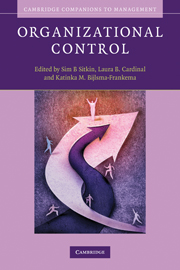Book contents
- Frontmatter
- Contents
- List of figures
- List of tables
- Contributors
- Foreword
- Part I Introduction and history
- 1 Control is fundamental
- 2 A historical perspective on organizational control
- Part II Conceptions of organizational control
- Part III Identity, attention, and motivation in organizational control
- Part IV Relational control
- Part V Managerial and strategic control
- Index of terms
- Author index
- References
2 - A historical perspective on organizational control
Published online by Cambridge University Press: 05 June 2012
- Frontmatter
- Contents
- List of figures
- List of tables
- Contributors
- Foreword
- Part I Introduction and history
- 1 Control is fundamental
- 2 A historical perspective on organizational control
- Part II Conceptions of organizational control
- Part III Identity, attention, and motivation in organizational control
- Part IV Relational control
- Part V Managerial and strategic control
- Index of terms
- Author index
- References
Summary
Organizational control: an old, familiar story
Repeatedly through the ages, people have come together to talk and learn about ways of exercising organizational control. From such interactions norms have emerged about effective behavior patterns, and some of these norms have been rendered explicit in codes, principles, laws, adages, edicts, and maxims, that is, in the discursive artifacts that people use to exercise political power and claim moral authority. As people have wanted to explain how an organization has exercised control at a particular time and place, they have constructed stories relating the situational facts to behavioral norms and institutional conditions. Over time, the assumptions that people have made about organizational control have changed too, and these assumptions have influenced the stories they have told. This chapter traces how organizational control has historically been understood.
We begin with one of the very few instances where contemporary organizational scholars have directly addressed the content of this deep human heritage. Specifically, Rindova and Starbuck (1997) describe how the ancient Chinese saw organizations and used conceptualizations of agency relationships to construct alternative ways to exercise organizational control. Next, we move to eighteenth-century Europe and then America and consider how the exercise of organizational control unfolded over time in the West. In particular, we describe how industrial bureaucracies developed and how people would often resist the associated organizational constraints. We consider how this resistance spawned efforts, in turn, to make organizational control more sensitive to human needs and more democratic.
- Type
- Chapter
- Information
- Organizational Control , pp. 16 - 48Publisher: Cambridge University PressPrint publication year: 2010
References
- 6
- Cited by

